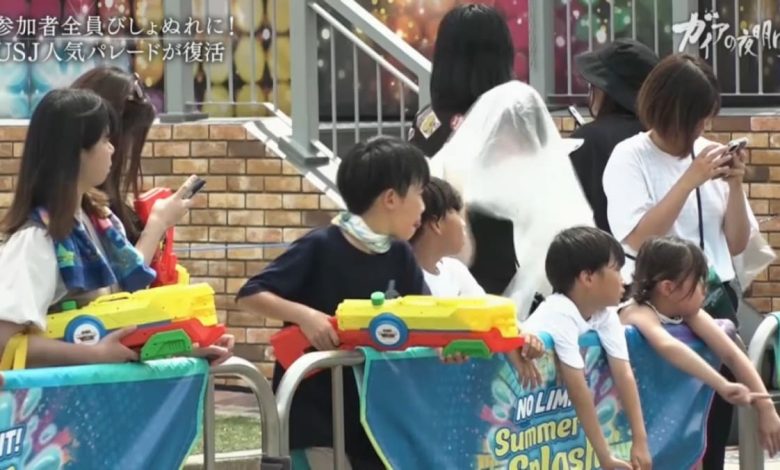Gaia Series 60 : Heading into the hottest summer ever

Universal Studios Japan (USJ) battles extreme heat while keeping visitors safe. In this episode, we see how they’re tackling rising temperatures this summer.
The searing heat of a Japanese summer is no small challenge, especially for a theme park that attracts thousands of visitors each day. In this episode, viewers get an inside look at Universal Studios Japan (USJ) in Osaka, which has implemented a series of innovative measures to protect its guests and staff from the record-breaking temperatures, all while reviving the much-loved Summer Splash Parade.
After four years of hiatus due to the COVID-19 pandemic, the Summer Splash Parade returned to USJ, much to the delight of visitors. “I got soaked!” one ecstatic participant exclaimed, holding a massive water gun. Families lined the streets, eager to experience the parade, which involves dancers spraying water at the crowd. A perfect respite from the oppressive 33.8°C heat that had engulfed Osaka that day, the parade couldn’t have returned at a better time.
To tackle this, USJ’s management, led by Akihiko Nishimura, has devised a clever way to cool down the park with what they call the “Mega Cool Zone.” Nishimura’s vision for the park this summer revolves around placing concentrated areas of mist fans that create a refreshing oasis for visitors to cool off. “It makes me really happy to see people finding the mist fans and taking a moment to rest underneath them,” Nishimura shared, reflecting on the impact of his project. He further explained that the fans lower the temperature by evaporating water mist, cooling the surrounding air by several degrees.
The statistics back up the necessity of such measures. Last year, Ibaraki Prefecture, where USJ is located, recorded 2,600 emergency hospitalisations for heat stroke, an all-time high, and claimed 1,600 lives last year. Tsukuba’s Memorial Hospital and Central Fire Department Fire Response Centre are the city’s first line of aid when it comes to heat-related incidents. As there is no specific form of treatment for heat stroke, medical staff use a 500ml sodium chloride drip, cooled to 5°C, which flows directly into a patient’s bloodstream. Cooling pillows and fans are also used to provide comfort to patients.
This year, with temperatures expected to rival last year’s, USJ has doubled its efforts, doubling the number of mist fans and launching the Mega Cool Zone in the park’s central area. Nine of these mist fan units now serve as a crucial part of USJ’s strategy to keep visitors safe under the scorching sun.
Beyond the Mega Cool Zone, USJ has also introduced an array of fun, water-themed attractions to combat the heat. Visitors can be seen engaging in water pistol fights, taking aim at targets in a designated water-play area. Nishimura explained that adding these playful elements enhances the summer experience for visitors: “It’s a great example of how we can provide new ways of enjoying summer that suit the USJ experience.”
However, the focus on safety extends beyond visitors. The episode takes viewers behind the scenes with the “Oasis Unit,” a group of park staff formed in 2020 who are dedicated to preventing heat stroke among their colleagues. Led by Yuji Shimada from the Human Resources department, the Oasis Unit patrols the park offering cold sports drinks to staff members. “Our crew members are incredible,” Shimada explained, “but they get so focused on making sure visitors have an amazing time that they forget to take care of themselves.” This 20-person team, equipped with tanks of cold drinks, cool towels and sodium pills, ensures that the park’s employees stay hydrated and healthy throughout the sweltering workday.
The toll of extreme heat is evident in the growing number of cases requiring first-aid attention. USJ’s two First Aid centres, staffed by a dedicated crew of nurses, have become an essential part of the park’s summer operations. “It gets extremely hot within the park grounds,” noted Keiko Kita, a nurse who has been working at USJ for over a year. With temperatures surpassing 30°C on many summer days, the First Aid centre often reaches full capacity, providing a cool place for visitors who have succumbed to the heat. If the nurse crew determines that a case is serious, the USJ ambulance will convey the patient to the hospital.
The park’s attention to visitor and staff safety comes at a critical time. Japan is experiencing some of the hottest summers on record, with global temperatures rising due to climate change. In fact, in 2023 alone, over 4,000 heat stroke cases were reported in schools. This is a stark reminder of the need for preventive measures across all sectors, particularly in public spaces like theme parks where outdoor activity is central.
Back at USJ, the excitement of the Summer Splash Parade offers a welcome distraction from the heat. Children laugh as water jets shoot from all directions, and the energy of the parade’s dancers fills the air. “I thought it would be tough without an umbrella,” admitted one park-goer, acknowledging the intensity of the sun. Yet, even under the blazing sun, the enthusiasm for the event remains high. As Nishimura noted, “I think there are some people who might consider staying home due to the extreme heat, but if they come to USJ, we can offer them many different ways to enjoy their summer safely.”
This episode captures both the excitement and challenges of a day at Universal Studios Japan. From the high-octane fun of the Summer Splash Parade to the behind-the-scenes efforts of the Oasis Unit and Mega Cool Zone, it’s clear that the park is committed to ensuring that summer visitors can beat the heat while still making unforgettable memories.

